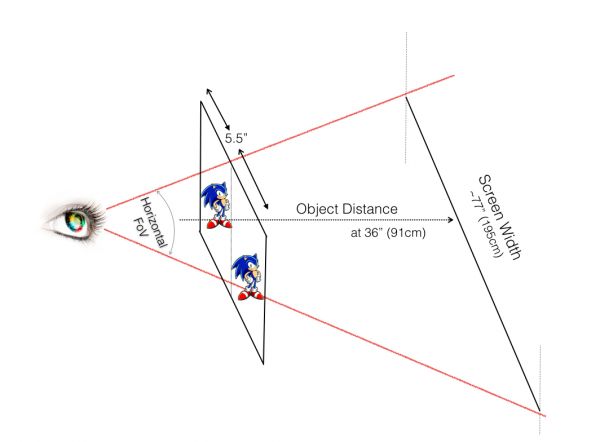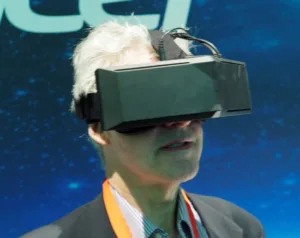Microsoft just announced that companies will be offering VR headsets for $299 and up and all powered by Windows “Holographic” technology. (Microsoft is developing a habit of using perfectly defined technical terms for marketing purposes without caring about the technical meaning.) These headsets are not HoloLens devices but are developed and manufactured by Microsoft associates like Acer, Asus, Dell, HP and Lenovo.

The editor trying a Starbreeze VR Headset, developed with Acer at IFA. He was unimpressed. Image:MekoThese devices will be tethered instead of using a wireless connection. During the Windows 10 Creator announcement, Microsoft spilled the beans about this development and more information will be announced in Microsoft events in December of this year. Since the headsets are supposed to hit the market in the first half of 2017 together with the release of Windows 10 Explorer, many analysts are expecting a major upswing in VR device sales and believe that Microsoft maybe able to put themselves into a market leadership role with this move.
There is some speculation about these devices in comparison of the HoloLens. Most reports refer to these new devices as VR sets versus the mixed reality (or AR) version used in the HoloLens. Obviously there will be significant differences that are also reflected in the much lower prices of these devices. For now let us assume that these are actually VR headsets.
Here is my view of the whole VR situation today and the immediate future.
VR Headsets are Displays
First and foremost all VR headsets are display devices, which will be compared to the image quality that the consumer has come to expect from smartphones, tablets, monitors, TVs, etc. With Oculus and HTC leading the pack in consumer relevant VR devices today, we should take a short look at what these devices offer to the consumer in terms of display performance.
When it comes to VR headsets, the user is basically strapping a display in front of his face that allows him to view a computer generated reality or recorded imagery through a peephole. With a horizontal field of vision off around 100 degrees it is a particular large peephole, but still much smaller than our human FoV. Basically all peripheral vision is being eliminated from this experience. One trend in the development of earlier headset models was an increase in FoV to make it a more ‘natural’ experience. Of course sensors will allow the user to turn his head and see whatever the content has in store in that particular direction, which means they can move the peephole around to see everything. This sensor technology makes it different from carrying a monitor around at arm’s length in a dark room.
But what is with the display itself? The Oculus Rift as one driver of this technology is using a 5.6” display with a resolution of 2,400 x 1,080 pixels. The display is about 5.1” x 2.3” in width and height. However, since we are using half of the display for one eye and the other half for the other eye, the resulting display size per eye is about 2.55” x 2.3” with a resolution of 1,200 x 1,080 pixels, not really a wide format display as we are used to see on most devices today.
With optical elements creating the virtual images and an eye relief from the lens surface of about 8mm we reach a horizontal field of view in the range of 90 – 95 degrees. There are measurements made by independent parties such as from Doc-Ok.org that confirm these FoV numbers as published by manufacturers and contains much more information and measurements in case you are interested in this topic.
Knowing the FoV and the display size gives you an idea of the display size as a function of distance from the eye. The further away you go the larger the image presented to the eye. At 3 feet (1m) distance, the display has a horizontal width of over 75”. All this is driven by a resolution of 1200 x 1080. This means a VR headset today gives you a similar image quality to an SXGA projector on a 75” wide screen viewed from a distance of 3 feet (1m). Not quite the same experience as a 4K 65” TV viewed from 10 feet (3m).

The Peephole Dilemma
To solve this resolution issue one can either increase the pixel density of the panels used (remember those talks about a 1,000 ppi OLED panel?) or limit the FoV. You may call this the peephole dilemma, the wider the FoV the lower the image quality or the better the image the narrower the FoV.
Of course, there are also other issues like refresh rates, contrast and persistence playing a role in the perceived image quality, however this peephole dilemma does not stop there. To drive today’s image limited VR headsets you already need a super high end PC, adding many more pixels to the mix and the requirements for the PC hardware becomes even more stringent. Taking into account the relative fast performance development of graphic cards this will only take a few years to fix. On the other hand it creates a chicken & egg issue for these high resolution display panels. Developing a 4K or above 5” type display panel needs some money and time and with relative low VR headset sales the motivation for display makers will not be overwhelming. Unless people will go for a 4K smartphone of course, which is not totally out of the question.
So, how long will it take for VR to become a device found in the house of the average consumer? Looking at the processing requirements, I would say at least two years based on today’s display capabilities. In this time, the display resolution will have increased by 20% to 40%, which is still a little low for a good VR experience.
I will throw my hat into the ring and guess that it will take 3-4 years before the fundamental requirements of displays and data processing have reached a level that allows for a great VR experience. For me, that is the point when a VR headset will give you the same image quality as a TV set at about 6 – 10 feet (2-3m). Nevertheless, in the meantime, people will start playing with it in entertainment as well as professional applications. However, comfortably using the VR headset for something like computing or watching TV will take that long or even longer if UHD with increased frame rates and HDR are being adopted swiftly. By the way, have you ever realized that video calls are kind of silly on a VR headset? (NH)

